|
|
Colonial Meetinghouses Featured in this Project
|
|
Below you will find information about, and photographs of, the specific
colonial meetinghouses featured in this project.
Principal photography for the publication and exhibition began in 2004, and concluded in 2008.
|
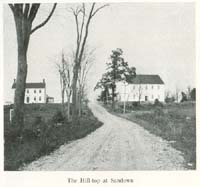
|
 The present Meeting House was built in 1771, replacing an older
structure located just to the northwest, across Hartford Road.
Under the close church-state relationship that formed colonial New England,
it was the responsibility of Brooklyn's taxpayers to erect a meeting house where the parish could gather on Sunday.
Accordingly, spaces for the 44 box pews planned for the ground floor were awarded to the 43 persons highest on the tax lists;
one pew continued as a ministerial pew, as it was in the smaller meeting house that preceded the new one.
People owned the pews if they also paid for their construction.
The present Meeting House was built in 1771, replacing an older
structure located just to the northwest, across Hartford Road.
Under the close church-state relationship that formed colonial New England,
it was the responsibility of Brooklyn's taxpayers to erect a meeting house where the parish could gather on Sunday.
Accordingly, spaces for the 44 box pews planned for the ground floor were awarded to the 43 persons highest on the tax lists;
one pew continued as a ministerial pew, as it was in the smaller meeting house that preceded the new one.
People owned the pews if they also paid for their construction.
 The beginnings of Trinity Church Brooklyn are solely attributable to one man: Godfrey Malbone.
The work, he confessed, was undertaken by him not only for religious motives,
but primarily as a means of saving himself from unjust and unreasonable taxation
to support the building of a new meetinghouse by the Ecclesiastical Society of Brooklyn.
Once his church was completed, a Colonial law would permit him to pay his Society taxes for the
support of services in that church rather than the "established" Congregational church.
However, the building would need to be completed prior to the completion of the Meetinghouse in the center of town.
The beginnings of Trinity Church Brooklyn are solely attributable to one man: Godfrey Malbone.
The work, he confessed, was undertaken by him not only for religious motives,
but primarily as a means of saving himself from unjust and unreasonable taxation
to support the building of a new meetinghouse by the Ecclesiastical Society of Brooklyn.
Once his church was completed, a Colonial law would permit him to pay his Society taxes for the
support of services in that church rather than the "established" Congregational church.
However, the building would need to be completed prior to the completion of the Meetinghouse in the center of town.
|
 The 40 by 52 foot building is one of the finest examples of a traditional New England meetinghouse in the state of Maine.
The Church was remodeled in 1822, with the addition of gallery pews, an entrance hall, and grain-painted woodwork.
Unlike many of the other meetinghouses of this period, the Alna meetinghouse has only one door.
The front (south) and back (north) walls are clapboarded, but the two ends are covered with shingles.
The 40 by 52 foot building is one of the finest examples of a traditional New England meetinghouse in the state of Maine.
The Church was remodeled in 1822, with the addition of gallery pews, an entrance hall, and grain-painted woodwork.
Unlike many of the other meetinghouses of this period, the Alna meetinghouse has only one door.
The front (south) and back (north) walls are clapboarded, but the two ends are covered with shingles.
 The need for an adequate meeting house had been apparent for several years
when in 1757 plans were drawn up and the Reverend Eaton,
perhaps finding local talent unavailable, enlisted his son and namesake to help with the construction.
According to his diary, Reverend Eaton made the sashes and frames for the building.
The Meeting House interior was of the utmost simplicity.
The overhead beams were hand hewn, joined and pegged.
The boards, one and one half inches thick, and the clapboards, were hand made and extra thick to keep out the cold.
The need for an adequate meeting house had been apparent for several years
when in 1757 plans were drawn up and the Reverend Eaton,
perhaps finding local talent unavailable, enlisted his son and namesake to help with the construction.
According to his diary, Reverend Eaton made the sashes and frames for the building.
The Meeting House interior was of the utmost simplicity.
The overhead beams were hand hewn, joined and pegged.
The boards, one and one half inches thick, and the clapboards, were hand made and extra thick to keep out the cold.
 Such a large town needed more than one meetinghouse to care for
the religious and other needs of the population,
and, after much deliberation in town meetings between 1766 and 1772,
it was finally determined that at least three meetinghouses were required:
one in Harrington (now Pemaquid) to take care of the Pemaquid and South Bristol regions,
one at Walpole to take care of the northwestern section of the town,
and one at Greenland Cove in what is now Bremen,
to take care of the northeastern section
including Round Pond.
Such a large town needed more than one meetinghouse to care for
the religious and other needs of the population,
and, after much deliberation in town meetings between 1766 and 1772,
it was finally determined that at least three meetinghouses were required:
one in Harrington (now Pemaquid) to take care of the Pemaquid and South Bristol regions,
one at Walpole to take care of the northwestern section of the town,
and one at Greenland Cove in what is now Bremen,
to take care of the northeastern section
including Round Pond.
 Built in 1772, the meetinghouse at Walpole, Maine is nearly identical to the one in Sandown, NH,
which was built a year or so later.
Even the arrangement of the pews is identical.
I am always amazed that in the 18th century, in a time
of difficult travel or communication even between near-by towns,
the meetinghouses of communities all across New England were so similar.
One difference with Walpole, however, is that the Walpole meetinghouse is clad in shingles (painted white)
instead of the quintessential New England clapboards.
Built in 1772, the meetinghouse at Walpole, Maine is nearly identical to the one in Sandown, NH,
which was built a year or so later.
Even the arrangement of the pews is identical.
I am always amazed that in the 18th century, in a time
of difficult travel or communication even between near-by towns,
the meetinghouses of communities all across New England were so similar.
One difference with Walpole, however, is that the Walpole meetinghouse is clad in shingles (painted white)
instead of the quintessential New England clapboards.
 The Old German Meetinghouse is believed to be as old as any church in Maine.
It was built in 1772 by a group of Reformed Lutherans on the eastern bank of the Medomak River.
At this time it was just an austere frame house which had been constructed and owned by thirty-two German Lutherans.
Many years passed before the plain interior showed the finish that is seen today,
with its square-benched pews, galleries and towering wineglass-shaped pulpit.
The Old German Meetinghouse is believed to be as old as any church in Maine.
It was built in 1772 by a group of Reformed Lutherans on the eastern bank of the Medomak River.
At this time it was just an austere frame house which had been constructed and owned by thirty-two German Lutherans.
Many years passed before the plain interior showed the finish that is seen today,
with its square-benched pews, galleries and towering wineglass-shaped pulpit.
|
 The Rocky Hill Meeting House is the best
preserved example of an original 18th century meetinghouse
interior in New England.
It was built in 1785 for church services and town meetings,
replacing a c. 1715 meetinghouse for the West Parish of Salisbury, Massachusetts (now part of Amesbury).
It was located on the only road that crossed the Powow River (via ferry),
leading to Salisbury Point and Portsmouth, New Hampshire.
Today we owe the existence of the Rocky Hill Meeting House to an accident of timing and location -
a circumstance that led to a decline in its use just a few decades after its construction.
The Rocky Hill Meeting House is the best
preserved example of an original 18th century meetinghouse
interior in New England.
It was built in 1785 for church services and town meetings,
replacing a c. 1715 meetinghouse for the West Parish of Salisbury, Massachusetts (now part of Amesbury).
It was located on the only road that crossed the Powow River (via ferry),
leading to Salisbury Point and Portsmouth, New Hampshire.
Today we owe the existence of the Rocky Hill Meeting House to an accident of timing and location -
a circumstance that led to a decline in its use just a few decades after its construction.
 The Old South Meeting House was built as a Puritan meetinghouse in 1729 at the corner of Milk and Marlborough (now Washington) Streets in the Center of Boston.
In the nearly 3 centuries since it was built, Old South has served the people of Boston in ways never imagined by its original builders.
Today, its steeple stands in stark contrast to the steel and glass skyscrapers that have grown up around it.
Its split banner weather vane, which is original, is the second oldest weather vane in the city of Boston.
The Old South Meeting House was built as a Puritan meetinghouse in 1729 at the corner of Milk and Marlborough (now Washington) Streets in the Center of Boston.
In the nearly 3 centuries since it was built, Old South has served the people of Boston in ways never imagined by its original builders.
Today, its steeple stands in stark contrast to the steel and glass skyscrapers that have grown up around it.
Its split banner weather vane, which is original, is the second oldest weather vane in the city of Boston.
 On the green in Cohasset, Massachusetts, stands the First Parish Meeting House,
which retains its outward appearance better than any other example of a meetinghouse still in current use in Massachusetts.
The main entrance (now the only one) is in the middle of the long southwest side.
Over the door rises a simple two-storied porch,
built in 1768,
the upper part of which was used as the minister's chamber.
On the green in Cohasset, Massachusetts, stands the First Parish Meeting House,
which retains its outward appearance better than any other example of a meetinghouse still in current use in Massachusetts.
The main entrance (now the only one) is in the middle of the long southwest side.
Over the door rises a simple two-storied porch,
built in 1768,
the upper part of which was used as the minister's chamber.
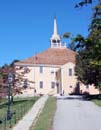 The Old Ship in Hingham, Massachusetts, is the oldest of the surviving meetinghouses.
It was built in 1681, and the curved roof beams resemble the inside of a ship.
Architecturally, the Old Ship is quite a bit different from the Meetinghouses that were built in the 1700s.
Its layout is essentially square, with a hip roof.
As with later meetinghouses, the main entrance faces south, and the interior layout consists of a high pulpit on the north wall,
and galleries on the other three walls.
The Old Ship in Hingham, Massachusetts, is the oldest of the surviving meetinghouses.
It was built in 1681, and the curved roof beams resemble the inside of a ship.
Architecturally, the Old Ship is quite a bit different from the Meetinghouses that were built in the 1700s.
Its layout is essentially square, with a hip roof.
As with later meetinghouses, the main entrance faces south, and the interior layout consists of a high pulpit on the north wall,
and galleries on the other three walls.
 The meetinghouse in Lynnfield is thought to be the third oldest Puritan meetinghouse in New England still standing on its original "green,"
and it claims to be the second oldest active meetinghouse in New England.
Built 61 years before the Revolutionary War, it is older than the Old South Meetinghouse, Faneuil Hall, or King's Chapel in Boston.
As one noted historian has said, 'it is without question the most historic building within the limits of the original town of Lynn.'
The meetinghouse in Lynnfield is thought to be the third oldest Puritan meetinghouse in New England still standing on its original "green,"
and it claims to be the second oldest active meetinghouse in New England.
Built 61 years before the Revolutionary War, it is older than the Old South Meetinghouse, Faneuil Hall, or King's Chapel in Boston.
As one noted historian has said, 'it is without question the most historic building within the limits of the original town of Lynn.'
 Built in the South Parish of Mendon, MA in 1769, the meetinghouse is an outstanding example of early preservation advocacy.
It served as a religious center for five villages for approximately 60 years at which time the population expansion
resulted in the formation of other churches in the town.
In 1896 the Chestnut Street Meeting House and Cemetery Association was chartered, and since that time has assumed the charge
of preserving and maintaining this remarkable two hundred and forty year old colonial structure.
Few substantial changes have been made to this piece of early American history, a claim shared with many other New England Meetinghouses.
Built in 1743, the Pelham Town Hall is the oldest town hall in continuous use in the United States.
The first Town Meeting was held in the meetinghouse on April 19, 1743, and the first minister, Rev. Robert Abercrombie, a Presbyterian from Edinburgh, was installed on August 30, 1744.
Built in the South Parish of Mendon, MA in 1769, the meetinghouse is an outstanding example of early preservation advocacy.
It served as a religious center for five villages for approximately 60 years at which time the population expansion
resulted in the formation of other churches in the town.
In 1896 the Chestnut Street Meeting House and Cemetery Association was chartered, and since that time has assumed the charge
of preserving and maintaining this remarkable two hundred and forty year old colonial structure.
Few substantial changes have been made to this piece of early American history, a claim shared with many other New England Meetinghouses.
Built in 1743, the Pelham Town Hall is the oldest town hall in continuous use in the United States.
The first Town Meeting was held in the meetinghouse on April 19, 1743, and the first minister, Rev. Robert Abercrombie, a Presbyterian from Edinburgh, was installed on August 30, 1744.
Located on Route 9 in Ware, Massachusetts, The Ware Center Meeting House,
which once served as the center of life in this rural community, is now among the ten most endangered historic structures in Massachusetts.
The current meetinghouse structure was built in 1799 and has served as the very first Town Hall, the first school, and the parish home for the First Church of Ware.
 In 1717, construction of the West Parish Meetinghouse began with the felling of nearby great oaks and pines.
The Meetinghouse was consecrated in 1719, and thus became the first permanent home of the Congregationalists who had first gathered 103 years earlier in England.
For the next 130 years, the Meetinghouse would also host Barnstable town meetings, and, for a time, the village public school.
In 1717, construction of the West Parish Meetinghouse began with the felling of nearby great oaks and pines.
The Meetinghouse was consecrated in 1719, and thus became the first permanent home of the Congregationalists who had first gathered 103 years earlier in England.
For the next 130 years, the Meetinghouse would also host Barnstable town meetings, and, for a time, the village public school.
|
 When it was originally constructed, the Province Road Meeting House in Belmont, New Hampshire was thought to have conformed to the classic meetinghouse design:
the building measured 52 feet by 40 feet with the south-facing main entrance along the long wall,
two story open interior with galleries (balconies) on 3 of the walls, a raised pulpit on the 4th (north) wall,
additional doors on the east and west walls, and box pews.
When it was originally constructed, the Province Road Meeting House in Belmont, New Hampshire was thought to have conformed to the classic meetinghouse design:
the building measured 52 feet by 40 feet with the south-facing main entrance along the long wall,
two story open interior with galleries (balconies) on 3 of the walls, a raised pulpit on the 4th (north) wall,
additional doors on the east and west walls, and box pews.
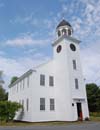 The Canaan Meeting House, built in 1793-96, was of a "typical" meetinghouse design, with the long wall facing south, doors on the east, south, and west walls, galleries also on those walls, and box pews both downstairs and in the galleries.
By 1970, it was evident that the evolution of the Canaan meetinghouse, coupled with the growth of the town, made the structure unsuitable for much of anything.
The Canaan Meeting House, built in 1793-96, was of a "typical" meetinghouse design, with the long wall facing south, doors on the east, south, and west walls, galleries also on those walls, and box pews both downstairs and in the galleries.
By 1970, it was evident that the evolution of the Canaan meetinghouse, coupled with the growth of the town, made the structure unsuitable for much of anything.
 This is another Anglican "meetinghouse," built by the early settlers who were members of
the Church of England.
Known as Trinity, this structure has preserved the Anglican form of
worship since 1793.
It is surrounded by "God's Acre,"
a term used in earlier times for the church's graveyard.
This is another Anglican "meetinghouse," built by the early settlers who were members of
the Church of England.
Known as Trinity, this structure has preserved the Anglican form of
worship since 1793.
It is surrounded by "God's Acre,"
a term used in earlier times for the church's graveyard.
 The meetinghouse at Danville is austere in its simplicity, except for its wonderful woodwork.
Only in the frame of the south doorway and the hoods over the front windows were the outside walls embellished;
wisely the beautification of the interior received the benefit of the meager taxes.
Here is the oldest high pulpit in New Hampshire,
displaying craftsmanship in every line of its panels and fluted pilasters and shapely sounding board.
The meetinghouse at Danville is austere in its simplicity, except for its wonderful woodwork.
Only in the frame of the south doorway and the hoods over the front windows were the outside walls embellished;
wisely the beautification of the interior received the benefit of the meager taxes.
Here is the oldest high pulpit in New Hampshire,
displaying craftsmanship in every line of its panels and fluted pilasters and shapely sounding board.
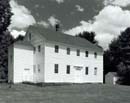 The meetinghouse in Fremont, NH was what started me on this project
of photographing colonial meetinghouses.
The Fremont Historical Society had an open house
in their meetinghouse, and there was an article in the paper.
I saved the article,
and about a year later I dug it out, contacted the society, and visited the place.
The rest is history, as they say.
The meetinghouse in Fremont, NH was what started me on this project
of photographing colonial meetinghouses.
The Fremont Historical Society had an open house
in their meetinghouse, and there was an article in the paper.
I saved the article,
and about a year later I dug it out, contacted the society, and visited the place.
The rest is history, as they say.
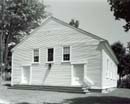 Building a meetinghouse in those days often took a long time.
The country was in the midst of its Revolution, and young manpower was scarce.
The frame for the meetinghouse was raised in September of 1774, and the roof was finished the next summer.
The floor was laid in 1777, pews were built in the following years, and more work was done on the interior in 1786.
The meetinghouse was finally finished in September of 1790 - sixteen years after it was begun.
Building a meetinghouse in those days often took a long time.
The country was in the midst of its Revolution, and young manpower was scarce.
The frame for the meetinghouse was raised in September of 1774, and the roof was finished the next summer.
The floor was laid in 1777, pews were built in the following years, and more work was done on the interior in 1786.
The meetinghouse was finally finished in September of 1790 - sixteen years after it was begun.
 The meetinghouse at Hampstead, New Hampshire now serves as a community center.
The interior has been substantially modernized,
and a floor has been added at the former balcony level.
However, the exterior is kept in its original style, and is well maintained by the town.
It is also one of the oldest surviving meetinghouses.
It was built in 1745, although the interior was not completed until 1792.
The belfry boasts an original Paul Revere bell.
In the 17th and 18th centuries, most New Hampshire religious buildings were meetinghouses,
with the entry in one long lateral facade and the pulpit on the opposite wall.
Only the Episcopalian churches adopted what later became the standard plan,
with the entry in one gable end and the pulpit at the opposite end of the building.
Trinity Church is therefore far more significant in the architectural history of the state
than its modest size and simple details would suggest.
The meetinghouse at Hampstead, New Hampshire now serves as a community center.
The interior has been substantially modernized,
and a floor has been added at the former balcony level.
However, the exterior is kept in its original style, and is well maintained by the town.
It is also one of the oldest surviving meetinghouses.
It was built in 1745, although the interior was not completed until 1792.
The belfry boasts an original Paul Revere bell.
In the 17th and 18th centuries, most New Hampshire religious buildings were meetinghouses,
with the entry in one long lateral facade and the pulpit on the opposite wall.
Only the Episcopalian churches adopted what later became the standard plan,
with the entry in one gable end and the pulpit at the opposite end of the building.
Trinity Church is therefore far more significant in the architectural history of the state
than its modest size and simple details would suggest.
 The town of Jaffrey, New Hampshire, boasts one of the most picturesque
meetinghouses, at least from the outside.
The frame was raised on June 17, 1775, which was also the day of the battle of Bunker Hill.
Tradition has it that the sound of the distant cannon fire could be heard by the workers.
The building is currently used as a community center, and the interior
has been substantially modified to be a small theatre.
Thankfully, a second floor was never added.
The town of Jaffrey, New Hampshire, boasts one of the most picturesque
meetinghouses, at least from the outside.
The frame was raised on June 17, 1775, which was also the day of the battle of Bunker Hill.
Tradition has it that the sound of the distant cannon fire could be heard by the workers.
The building is currently used as a community center, and the interior
has been substantially modified to be a small theatre.
Thankfully, a second floor was never added.
 For over 200 years, Langdon residents have appreciated the role that their Town Hall (the Meetinghouse) has had in their lives.
It began as both a place of worship and the seat of town government, and is still used as the center of social and community activities.
For over 200 years, Langdon residents have appreciated the role that their Town Hall (the Meetinghouse) has had in their lives.
It began as both a place of worship and the seat of town government, and is still used as the center of social and community activities.
 The Lempster meetinghouse was built in 1794 as a Congregational Church
and for civic affairs.
When it was first constructed it was a large, tall, and rectangular building
with double side entries with double holy doors.
Opposite the main entry was a raised pulpit with a window behind the pulpit.
The exact location of the first meetinghouse is not clearly known,
only the general vicinity of the building.
The Lempster meetinghouse was built in 1794 as a Congregational Church
and for civic affairs.
When it was first constructed it was a large, tall, and rectangular building
with double side entries with double holy doors.
Opposite the main entry was a raised pulpit with a window behind the pulpit.
The exact location of the first meetinghouse is not clearly known,
only the general vicinity of the building.
 The most famous building in Sandown is its former town hall, which since 1835 has been called "The Old Meeting House."
Sandown is credited by many with possessing the finest meetinghouse in New Hampshire - and there are those who would go so far as to say the finest in America.
For 155 years, the good men and women of Sandown gathered at this building to set their own taxes and to draft their own laws.
This building was, to a great extent, the capitol of a small, semi-autonomous republic operating inside New Hampshire.
The most famous building in Sandown is its former town hall, which since 1835 has been called "The Old Meeting House."
Sandown is credited by many with possessing the finest meetinghouse in New Hampshire - and there are those who would go so far as to say the finest in America.
For 155 years, the good men and women of Sandown gathered at this building to set their own taxes and to draft their own laws.
This building was, to a great extent, the capitol of a small, semi-autonomous republic operating inside New Hampshire.
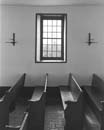 Several meetinghouses were built, only to be burned by the ungodly fishermen, according to tradition.
In 1800, a stone chapel was erected with its interior furnishings
made from the timbers of a Spanish shipwreck.
The village has disappeared, and, except for the grass-grown cemetery, all traces
of the former settlers are lost.
Many monuments mark historic sites,
memorials to those who once lived on the islands.
Above them all, the little stone chapel guards the graves of the forgotten people.
Several meetinghouses were built, only to be burned by the ungodly fishermen, according to tradition.
In 1800, a stone chapel was erected with its interior furnishings
made from the timbers of a Spanish shipwreck.
The village has disappeared, and, except for the grass-grown cemetery, all traces
of the former settlers are lost.
Many monuments mark historic sites,
memorials to those who once lived on the islands.
Above them all, the little stone chapel guards the graves of the forgotten people.
 The meetinghouse at Webster, New Hampshire is relatively untouched
from its original design,
except for the addition of a 2nd floor at the balcony level.
It was built in 1791,
and was used for worship until 1823 when the "new" church was built.
After that, it was used for town business for many years.
Today it seems to be used as an historical society museum,
although there does not seem to be a lot of activity.
The meetinghouse at Webster, New Hampshire is relatively untouched
from its original design,
except for the addition of a 2nd floor at the balcony level.
It was built in 1791,
and was used for worship until 1823 when the "new" church was built.
After that, it was used for town business for many years.
Today it seems to be used as an historical society museum,
although there does not seem to be a lot of activity.
|
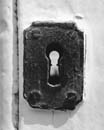
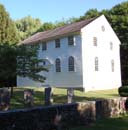 The Old Narragansett Church in Wickford, Rhode Island is the oldest Episcopal church building north of the Potomac River.
Among its interesting features are its box pews, Palladian windows, oversize reading desk, and old fashioned wine glass pulpit.
The organ was built by Bernard Smith in England circa 1660, and it has been restored to this state by Richard Hedgebeth.
It has 196 speaking pipes, all of wood.
It is believed to be the oldest church organ in use for church services in the United States.
The Old Narragansett Church in Wickford, Rhode Island is the oldest Episcopal church building north of the Potomac River.
Among its interesting features are its box pews, Palladian windows, oversize reading desk, and old fashioned wine glass pulpit.
The organ was built by Bernard Smith in England circa 1660, and it has been restored to this state by Richard Hedgebeth.
It has 196 speaking pipes, all of wood.
It is believed to be the oldest church organ in use for church services in the United States.
|
 The Rockingham Meeting House is one of the finest examples of Colonial-style church architecture still remaining in New England, and is the oldest public building in Vermont that still exists in its original state.
The building stood unused for some decades and suffered vandalism and loss of contents, but in 1906, after a fire which destroyed many buildings in the village, people of the town and the surrounding area recognized that the meetinghouse was a well-preserved historical and architectural treasure, and raised funds for its restoration.
The Rockingham Meeting House is one of the finest examples of Colonial-style church architecture still remaining in New England, and is the oldest public building in Vermont that still exists in its original state.
The building stood unused for some decades and suffered vandalism and loss of contents, but in 1906, after a fire which destroyed many buildings in the village, people of the town and the surrounding area recognized that the meetinghouse was a well-preserved historical and architectural treasure, and raised funds for its restoration.
|
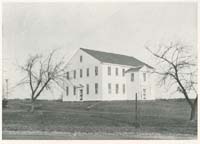
Acknowledgements
Historical photographs included in these pages are from Eva Speare's book
Colonial Meetinghouses of New Hampshire,
published in 1938.
See the
bibliography page for this and other existing books on Colonial Meetinghouses.
|

 The present Meeting House was built in 1771, replacing an older
structure located just to the northwest, across Hartford Road.
Under the close church-state relationship that formed colonial New England,
it was the responsibility of Brooklyn's taxpayers to erect a meeting house where the parish could gather on Sunday.
Accordingly, spaces for the 44 box pews planned for the ground floor were awarded to the 43 persons highest on the tax lists;
one pew continued as a ministerial pew, as it was in the smaller meeting house that preceded the new one.
People owned the pews if they also paid for their construction.
The present Meeting House was built in 1771, replacing an older
structure located just to the northwest, across Hartford Road.
Under the close church-state relationship that formed colonial New England,
it was the responsibility of Brooklyn's taxpayers to erect a meeting house where the parish could gather on Sunday.
Accordingly, spaces for the 44 box pews planned for the ground floor were awarded to the 43 persons highest on the tax lists;
one pew continued as a ministerial pew, as it was in the smaller meeting house that preceded the new one.
People owned the pews if they also paid for their construction.
 The beginnings of Trinity Church Brooklyn are solely attributable to one man: Godfrey Malbone.
The work, he confessed, was undertaken by him not only for religious motives,
but primarily as a means of saving himself from unjust and unreasonable taxation
to support the building of a new meetinghouse by the Ecclesiastical Society of Brooklyn.
Once his church was completed, a Colonial law would permit him to pay his Society taxes for the
support of services in that church rather than the "established" Congregational church.
However, the building would need to be completed prior to the completion of the Meetinghouse in the center of town.
The beginnings of Trinity Church Brooklyn are solely attributable to one man: Godfrey Malbone.
The work, he confessed, was undertaken by him not only for religious motives,
but primarily as a means of saving himself from unjust and unreasonable taxation
to support the building of a new meetinghouse by the Ecclesiastical Society of Brooklyn.
Once his church was completed, a Colonial law would permit him to pay his Society taxes for the
support of services in that church rather than the "established" Congregational church.
However, the building would need to be completed prior to the completion of the Meetinghouse in the center of town.

 The need for an adequate meeting house had been apparent for several years
when in 1757 plans were drawn up and the Reverend Eaton,
perhaps finding local talent unavailable, enlisted his son and namesake to help with the construction.
According to his diary, Reverend Eaton made the sashes and frames for the building.
The Meeting House interior was of the utmost simplicity.
The overhead beams were hand hewn, joined and pegged.
The boards, one and one half inches thick, and the clapboards, were hand made and extra thick to keep out the cold.
The need for an adequate meeting house had been apparent for several years
when in 1757 plans were drawn up and the Reverend Eaton,
perhaps finding local talent unavailable, enlisted his son and namesake to help with the construction.
According to his diary, Reverend Eaton made the sashes and frames for the building.
The Meeting House interior was of the utmost simplicity.
The overhead beams were hand hewn, joined and pegged.
The boards, one and one half inches thick, and the clapboards, were hand made and extra thick to keep out the cold.
 Such a large town needed more than one meetinghouse to care for
the religious and other needs of the population,
and, after much deliberation in town meetings between 1766 and 1772,
it was finally determined that at least three meetinghouses were required:
one in Harrington (now Pemaquid) to take care of the Pemaquid and South Bristol regions,
one at Walpole to take care of the northwestern section of the town,
and one at Greenland Cove in what is now Bremen,
to take care of the northeastern section
including Round Pond.
Such a large town needed more than one meetinghouse to care for
the religious and other needs of the population,
and, after much deliberation in town meetings between 1766 and 1772,
it was finally determined that at least three meetinghouses were required:
one in Harrington (now Pemaquid) to take care of the Pemaquid and South Bristol regions,
one at Walpole to take care of the northwestern section of the town,
and one at Greenland Cove in what is now Bremen,
to take care of the northeastern section
including Round Pond.
 Built in 1772, the meetinghouse at Walpole, Maine is nearly identical to the one in Sandown, NH,
which was built a year or so later.
Even the arrangement of the pews is identical.
I am always amazed that in the 18th century, in a time
of difficult travel or communication even between near-by towns,
the meetinghouses of communities all across New England were so similar.
One difference with Walpole, however, is that the Walpole meetinghouse is clad in shingles (painted white)
instead of the quintessential New England clapboards.
Built in 1772, the meetinghouse at Walpole, Maine is nearly identical to the one in Sandown, NH,
which was built a year or so later.
Even the arrangement of the pews is identical.
I am always amazed that in the 18th century, in a time
of difficult travel or communication even between near-by towns,
the meetinghouses of communities all across New England were so similar.
One difference with Walpole, however, is that the Walpole meetinghouse is clad in shingles (painted white)
instead of the quintessential New England clapboards.
 The Old German Meetinghouse is believed to be as old as any church in Maine.
It was built in 1772 by a group of Reformed Lutherans on the eastern bank of the Medomak River.
At this time it was just an austere frame house which had been constructed and owned by thirty-two German Lutherans.
Many years passed before the plain interior showed the finish that is seen today,
with its square-benched pews, galleries and towering wineglass-shaped pulpit.
The Old German Meetinghouse is believed to be as old as any church in Maine.
It was built in 1772 by a group of Reformed Lutherans on the eastern bank of the Medomak River.
At this time it was just an austere frame house which had been constructed and owned by thirty-two German Lutherans.
Many years passed before the plain interior showed the finish that is seen today,
with its square-benched pews, galleries and towering wineglass-shaped pulpit.
 The Rocky Hill Meeting House is the best
preserved example of an original 18th century meetinghouse
interior in New England.
It was built in 1785 for church services and town meetings,
replacing a c. 1715 meetinghouse for the West Parish of Salisbury, Massachusetts (now part of Amesbury).
It was located on the only road that crossed the Powow River (via ferry),
leading to Salisbury Point and Portsmouth, New Hampshire.
Today we owe the existence of the Rocky Hill Meeting House to an accident of timing and location -
a circumstance that led to a decline in its use just a few decades after its construction.
The Rocky Hill Meeting House is the best
preserved example of an original 18th century meetinghouse
interior in New England.
It was built in 1785 for church services and town meetings,
replacing a c. 1715 meetinghouse for the West Parish of Salisbury, Massachusetts (now part of Amesbury).
It was located on the only road that crossed the Powow River (via ferry),
leading to Salisbury Point and Portsmouth, New Hampshire.
Today we owe the existence of the Rocky Hill Meeting House to an accident of timing and location -
a circumstance that led to a decline in its use just a few decades after its construction.
 The Old South Meeting House was built as a Puritan meetinghouse in 1729 at the corner of Milk and Marlborough (now Washington) Streets in the Center of Boston.
In the nearly 3 centuries since it was built, Old South has served the people of Boston in ways never imagined by its original builders.
Today, its steeple stands in stark contrast to the steel and glass skyscrapers that have grown up around it.
Its split banner weather vane, which is original, is the second oldest weather vane in the city of Boston.
The Old South Meeting House was built as a Puritan meetinghouse in 1729 at the corner of Milk and Marlborough (now Washington) Streets in the Center of Boston.
In the nearly 3 centuries since it was built, Old South has served the people of Boston in ways never imagined by its original builders.
Today, its steeple stands in stark contrast to the steel and glass skyscrapers that have grown up around it.
Its split banner weather vane, which is original, is the second oldest weather vane in the city of Boston.
 On the green in Cohasset, Massachusetts, stands the First Parish Meeting House,
which retains its outward appearance better than any other example of a meetinghouse still in current use in Massachusetts.
The main entrance (now the only one) is in the middle of the long southwest side.
Over the door rises a simple two-storied porch,
built in 1768,
the upper part of which was used as the minister's chamber.
On the green in Cohasset, Massachusetts, stands the First Parish Meeting House,
which retains its outward appearance better than any other example of a meetinghouse still in current use in Massachusetts.
The main entrance (now the only one) is in the middle of the long southwest side.
Over the door rises a simple two-storied porch,
built in 1768,
the upper part of which was used as the minister's chamber.
 The Old Ship in Hingham, Massachusetts, is the oldest of the surviving meetinghouses.
It was built in 1681, and the curved roof beams resemble the inside of a ship.
Architecturally, the Old Ship is quite a bit different from the Meetinghouses that were built in the 1700s.
Its layout is essentially square, with a hip roof.
As with later meetinghouses, the main entrance faces south, and the interior layout consists of a high pulpit on the north wall,
and galleries on the other three walls.
The Old Ship in Hingham, Massachusetts, is the oldest of the surviving meetinghouses.
It was built in 1681, and the curved roof beams resemble the inside of a ship.
Architecturally, the Old Ship is quite a bit different from the Meetinghouses that were built in the 1700s.
Its layout is essentially square, with a hip roof.
As with later meetinghouses, the main entrance faces south, and the interior layout consists of a high pulpit on the north wall,
and galleries on the other three walls.
 The meetinghouse in Lynnfield is thought to be the third oldest Puritan meetinghouse in New England still standing on its original "green,"
and it claims to be the second oldest active meetinghouse in New England.
Built 61 years before the Revolutionary War, it is older than the Old South Meetinghouse, Faneuil Hall, or King's Chapel in Boston.
As one noted historian has said, 'it is without question the most historic building within the limits of the original town of Lynn.'
The meetinghouse in Lynnfield is thought to be the third oldest Puritan meetinghouse in New England still standing on its original "green,"
and it claims to be the second oldest active meetinghouse in New England.
Built 61 years before the Revolutionary War, it is older than the Old South Meetinghouse, Faneuil Hall, or King's Chapel in Boston.
As one noted historian has said, 'it is without question the most historic building within the limits of the original town of Lynn.'
 Built in the South Parish of Mendon, MA in 1769, the meetinghouse is an outstanding example of early preservation advocacy.
It served as a religious center for five villages for approximately 60 years at which time the population expansion
resulted in the formation of other churches in the town.
In 1896 the Chestnut Street Meeting House and Cemetery Association was chartered, and since that time has assumed the charge
of preserving and maintaining this remarkable two hundred and forty year old colonial structure.
Few substantial changes have been made to this piece of early American history, a claim shared with many other New England Meetinghouses.
Built in the South Parish of Mendon, MA in 1769, the meetinghouse is an outstanding example of early preservation advocacy.
It served as a religious center for five villages for approximately 60 years at which time the population expansion
resulted in the formation of other churches in the town.
In 1896 the Chestnut Street Meeting House and Cemetery Association was chartered, and since that time has assumed the charge
of preserving and maintaining this remarkable two hundred and forty year old colonial structure.
Few substantial changes have been made to this piece of early American history, a claim shared with many other New England Meetinghouses.



 The meetinghouse at Danville is austere in its simplicity, except for its wonderful woodwork.
Only in the frame of the south doorway and the hoods over the front windows were the outside walls embellished;
wisely the beautification of the interior received the benefit of the meager taxes.
Here is the oldest high pulpit in New Hampshire,
displaying craftsmanship in every line of its panels and fluted pilasters and shapely sounding board.
The meetinghouse at Danville is austere in its simplicity, except for its wonderful woodwork.
Only in the frame of the south doorway and the hoods over the front windows were the outside walls embellished;
wisely the beautification of the interior received the benefit of the meager taxes.
Here is the oldest high pulpit in New Hampshire,
displaying craftsmanship in every line of its panels and fluted pilasters and shapely sounding board.
 The meetinghouse in Fremont, NH was what started me on this project
of photographing colonial meetinghouses.
The Fremont Historical Society had an open house
in their meetinghouse, and there was an article in the paper.
I saved the article,
and about a year later I dug it out, contacted the society, and visited the place.
The rest is history, as they say.
The meetinghouse in Fremont, NH was what started me on this project
of photographing colonial meetinghouses.
The Fremont Historical Society had an open house
in their meetinghouse, and there was an article in the paper.
I saved the article,
and about a year later I dug it out, contacted the society, and visited the place.
The rest is history, as they say.
 Building a meetinghouse in those days often took a long time.
The country was in the midst of its Revolution, and young manpower was scarce.
The frame for the meetinghouse was raised in September of 1774, and the roof was finished the next summer.
The floor was laid in 1777, pews were built in the following years, and more work was done on the interior in 1786.
The meetinghouse was finally finished in September of 1790 - sixteen years after it was begun.
Building a meetinghouse in those days often took a long time.
The country was in the midst of its Revolution, and young manpower was scarce.
The frame for the meetinghouse was raised in September of 1774, and the roof was finished the next summer.
The floor was laid in 1777, pews were built in the following years, and more work was done on the interior in 1786.
The meetinghouse was finally finished in September of 1790 - sixteen years after it was begun.
 The meetinghouse at Hampstead, New Hampshire now serves as a community center.
The interior has been substantially modernized,
and a floor has been added at the former balcony level.
However, the exterior is kept in its original style, and is well maintained by the town.
It is also one of the oldest surviving meetinghouses.
It was built in 1745, although the interior was not completed until 1792.
The belfry boasts an original Paul Revere bell.
The meetinghouse at Hampstead, New Hampshire now serves as a community center.
The interior has been substantially modernized,
and a floor has been added at the former balcony level.
However, the exterior is kept in its original style, and is well maintained by the town.
It is also one of the oldest surviving meetinghouses.
It was built in 1745, although the interior was not completed until 1792.
The belfry boasts an original Paul Revere bell.







 In 1717, construction of the West Parish Meetinghouse began with the felling of nearby great oaks and pines.
The Meetinghouse was consecrated in 1719, and thus became the first permanent home of the Congregationalists who had first gathered 103 years earlier in England.
For the next 130 years, the Meetinghouse would also host Barnstable town meetings, and, for a time, the village public school.
In 1717, construction of the West Parish Meetinghouse began with the felling of nearby great oaks and pines.
The Meetinghouse was consecrated in 1719, and thus became the first permanent home of the Congregationalists who had first gathered 103 years earlier in England.
For the next 130 years, the Meetinghouse would also host Barnstable town meetings, and, for a time, the village public school.
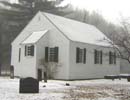
 The town of Jaffrey, New Hampshire, boasts one of the most picturesque
meetinghouses, at least from the outside.
The frame was raised on June 17, 1775, which was also the day of the battle of Bunker Hill.
Tradition has it that the sound of the distant cannon fire could be heard by the workers.
The building is currently used as a community center, and the interior
has been substantially modified to be a small theatre.
Thankfully, a second floor was never added.
The town of Jaffrey, New Hampshire, boasts one of the most picturesque
meetinghouses, at least from the outside.
The frame was raised on June 17, 1775, which was also the day of the battle of Bunker Hill.
Tradition has it that the sound of the distant cannon fire could be heard by the workers.
The building is currently used as a community center, and the interior
has been substantially modified to be a small theatre.
Thankfully, a second floor was never added.


 The most famous building in Sandown is its former town hall, which since 1835 has been called "The Old Meeting House."
Sandown is credited by many with possessing the finest meetinghouse in New Hampshire - and there are those who would go so far as to say the finest in America.
For 155 years, the good men and women of Sandown gathered at this building to set their own taxes and to draft their own laws.
This building was, to a great extent, the capitol of a small, semi-autonomous republic operating inside New Hampshire.
The most famous building in Sandown is its former town hall, which since 1835 has been called "The Old Meeting House."
Sandown is credited by many with possessing the finest meetinghouse in New Hampshire - and there are those who would go so far as to say the finest in America.
For 155 years, the good men and women of Sandown gathered at this building to set their own taxes and to draft their own laws.
This building was, to a great extent, the capitol of a small, semi-autonomous republic operating inside New Hampshire.
 Several meetinghouses were built, only to be burned by the ungodly fishermen, according to tradition.
In 1800, a stone chapel was erected with its interior furnishings
made from the timbers of a Spanish shipwreck.
The village has disappeared, and, except for the grass-grown cemetery, all traces
of the former settlers are lost.
Many monuments mark historic sites,
memorials to those who once lived on the islands.
Above them all, the little stone chapel guards the graves of the forgotten people.
Several meetinghouses were built, only to be burned by the ungodly fishermen, according to tradition.
In 1800, a stone chapel was erected with its interior furnishings
made from the timbers of a Spanish shipwreck.
The village has disappeared, and, except for the grass-grown cemetery, all traces
of the former settlers are lost.
Many monuments mark historic sites,
memorials to those who once lived on the islands.
Above them all, the little stone chapel guards the graves of the forgotten people.
 The meetinghouse at Webster, New Hampshire is relatively untouched
from its original design,
except for the addition of a 2nd floor at the balcony level.
It was built in 1791,
and was used for worship until 1823 when the "new" church was built.
After that, it was used for town business for many years.
Today it seems to be used as an historical society museum,
although there does not seem to be a lot of activity.
The meetinghouse at Webster, New Hampshire is relatively untouched
from its original design,
except for the addition of a 2nd floor at the balcony level.
It was built in 1791,
and was used for worship until 1823 when the "new" church was built.
After that, it was used for town business for many years.
Today it seems to be used as an historical society museum,
although there does not seem to be a lot of activity.